YAMAHA SUPERJET 2022 Service Manual
Manufacturer: YAMAHA, Model Year: 2022, Model line: SUPERJET, Model: YAMAHA SUPERJET 2022Pages: 84, PDF Size: 3.76 MB
Page 41 of 84
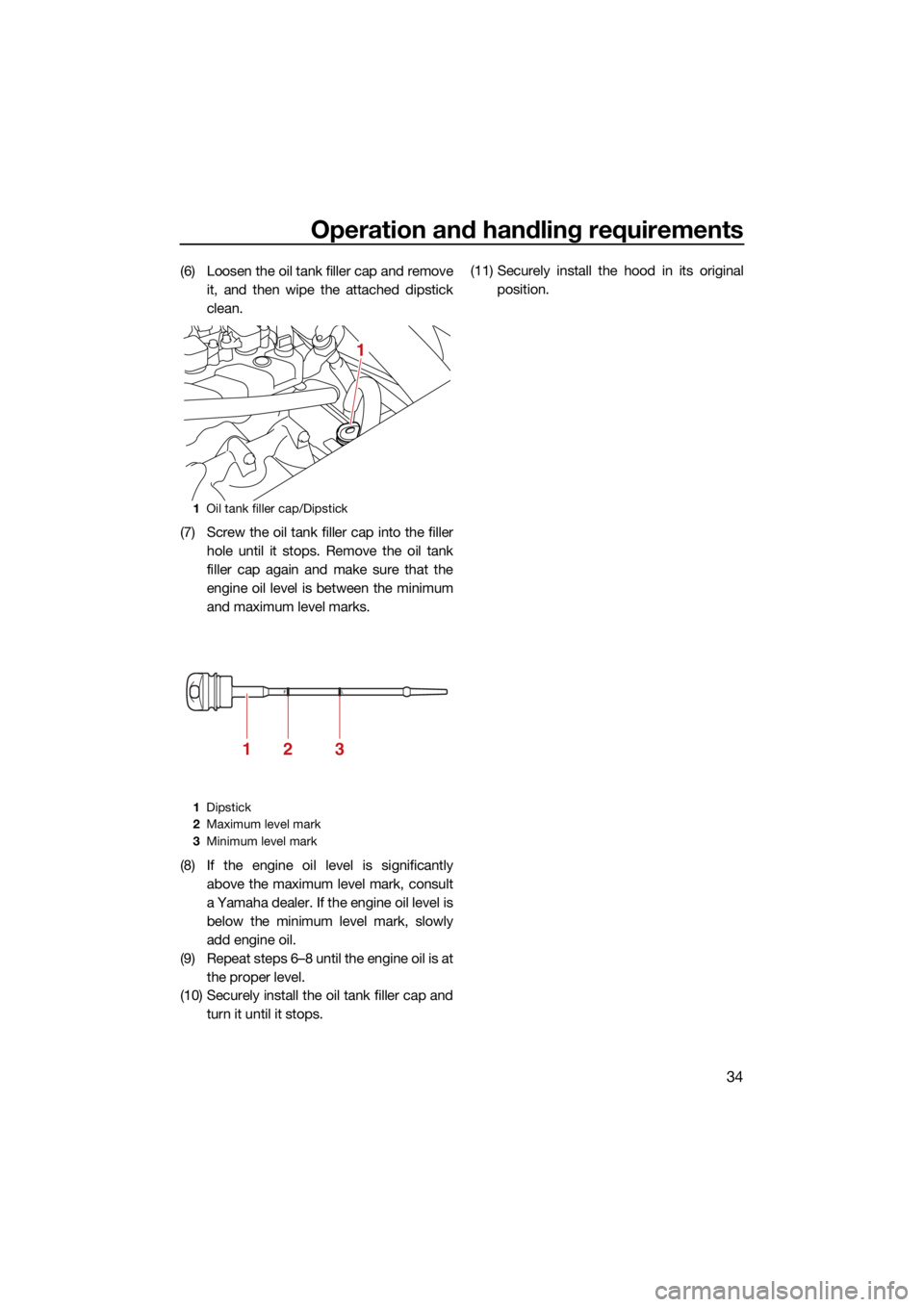
Operation and handling requirements
34
(6) Loosen the oil tank filler cap and removeit, and then wipe the attached dipstick
clean.
(7) Screw the oil tank filler cap into the filler hole until it stops. Remove the oil tank
filler cap again and make sure that the
engine oil level is between the minimum
and maximum level marks.
(8) If the engine oil level is significantly above the maximum level mark, consult
a Yamaha dealer. If the engine oil level is
below the minimum level mark, slowly
add engine oil.
(9) Repeat steps 6–8 until the engine oil is at the proper level.
(10) Securely install the oil tank filler cap and turn it until it stops. (11) Securely install the hood in its original
position.
1Oil tank filler cap/Dipstick
1 Dipstick
2 Maximum level mark
3 Minimum level mark
1
213
UF4R71E0.book Page 34 Monday, May 10, 2021 1:14 PM
Page 42 of 84
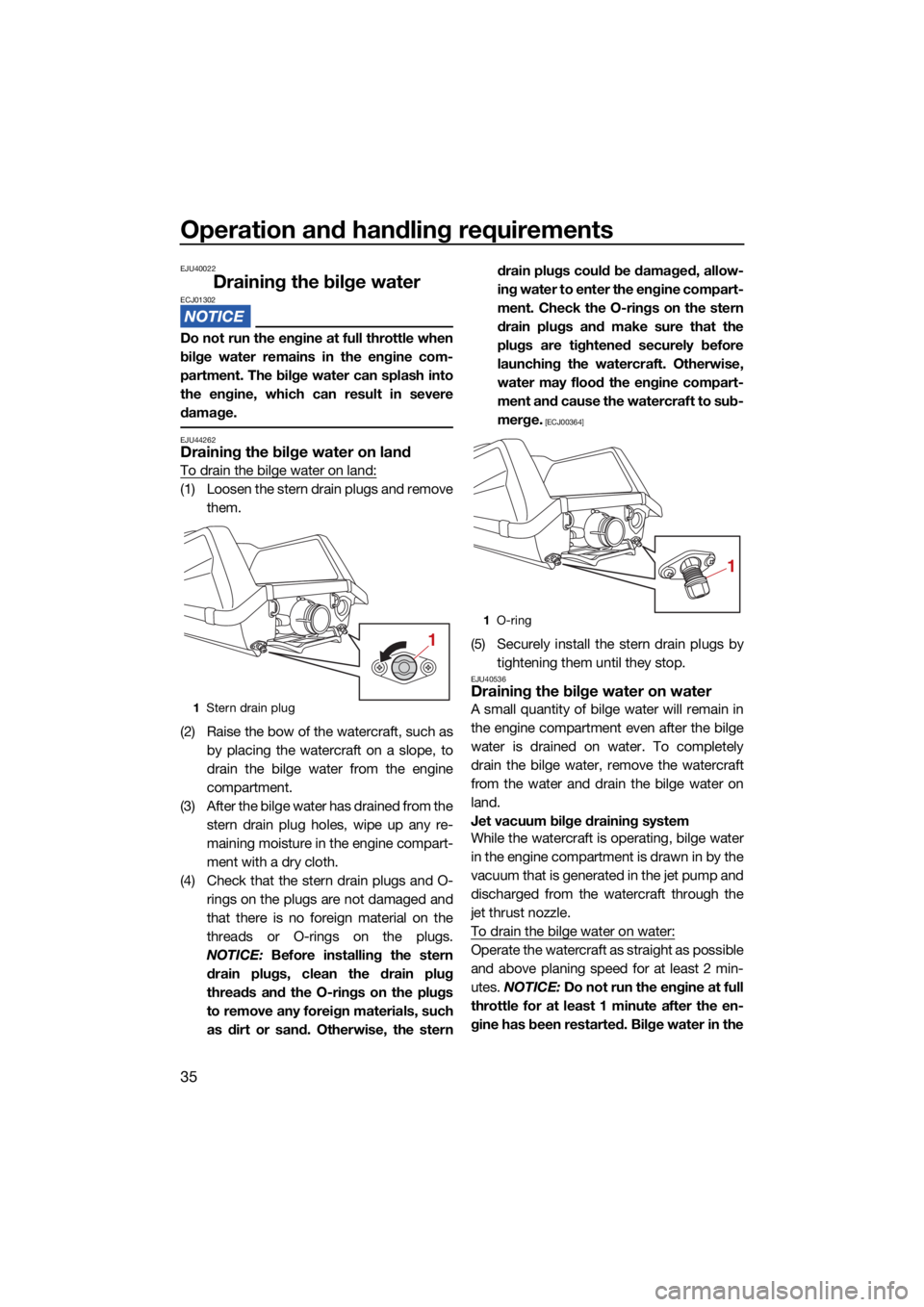
Operation and handling requirements
35
EJU40022
Draining the bilge waterECJ01302
Do not run the engine at full throttle when
bilge water remains in the engine com-
partment. The bilge water can splash into
the engine, which can result in severe
damage.
EJU44262Draining the bilge water on land
To drain the bilge water on land:
(1) Loosen the stern drain plugs and removethem.
(2) Raise the bow of the watercraft, such as by placing the watercraft on a slope, to
drain the bilge water from the engine
compartment.
(3) After the bilge water has drained from the stern drain plug holes, wipe up any re-
maining moisture in the engine compart-
ment with a dry cloth.
(4) Check that the stern drain plugs and O- rings on the plugs are not damaged and
that there is no foreign material on the
threads or O-rings on the plugs.
NOTICE: Before installing the stern
drain plugs, clean the drain plug
threads and the O-rings on the plugs
to remove any foreign materials, such
as dirt or sand. Otherwise, the stern drain plugs could be damaged, allow-
ing water to enter the engine compart-
ment. Check the O-rings on the stern
drain plugs and make sure that the
plugs are tightened securely before
launching the watercraft. Otherwise,
water may flood the engine compart-
ment and cause the watercraft to sub-
merge.
[ECJ00364]
(5) Securely install the stern drain plugs by
tightening them until they stop.
EJU40536Draining the bilge water on water
A small quantity of bilge water will remain in
the engine compartment even after the bilge
water is drained on water. To completely
drain the bilge water, remove the watercraft
from the water and drain the bilge water on
land.
Jet vacuum bilge draining system
While the watercraft is operating, bilge water
in the engine compartment is drawn in by the
vacuum that is generated in the jet pump and
discharged from the watercraft through the
jet thrust nozzle.
To drain the bilge water on water:
Operate the watercraft as straight as possible
and above planing speed for at least 2 min-
utes. NOTICE: Do not run the engine at full
throttle for at least 1 minute after the en-
gine has been restarted. Bilge water in the
1 Stern drain plug
1
1O-ring
1
UF4R71E0.book Page 35 Monday, May 10, 2021 1:14 PM
Page 43 of 84
![YAMAHA SUPERJET 2022 Service Manual Operation and handling requirements
36
engine compartment can splash into the
engine, which can result in severe dam-
age.
[ECJ00554]EJU45602
Transporting on a trailer
When transporting the watercraf YAMAHA SUPERJET 2022 Service Manual Operation and handling requirements
36
engine compartment can splash into the
engine, which can result in severe dam-
age.
[ECJ00554]EJU45602
Transporting on a trailer
When transporting the watercraf](/img/51/51248/w960_51248-42.png)
Operation and handling requirements
36
engine compartment can splash into the
engine, which can result in severe dam-
age.
[ECJ00554]EJU45602
Transporting on a trailer
When transporting the watercraft on a trailer,
secure the tie downs to the trailer through the
bow eye and stern eyes. Use a rubber shock
cord to secure the steering pole to the water-
craft.
NOTICE: Do not attach ropes or tie
downs to any part of the watercraft other
than the bow eye and stern eyes to secure
the watercraft to the trailer. Otherwise, the
watercraft may be damaged. Wrap the
ropes or tie downs with towels or rags
where they touch the body of the water-
craft to avoid scratches or damage. Do
not secure the steering pole with ropes or
tie downs and do not secure it to the trail-
er. Also, do not transport the watercraft
UF4R71E0.book Page 36 Monday, May 10, 2021 1:14 PM
Page 44 of 84
![YAMAHA SUPERJET 2022 Service Manual Operation and handling requirements
37
with the steering pole up. Otherwise, the
steering pole could be damaged.
[ECJ02820]
1Rubber shock cord
1
UF4R71E0.book Page 37 Monday, May 10, 2021 1:14 PM YAMAHA SUPERJET 2022 Service Manual Operation and handling requirements
37
with the steering pole up. Otherwise, the
steering pole could be damaged.
[ECJ02820]
1Rubber shock cord
1
UF4R71E0.book Page 37 Monday, May 10, 2021 1:14 PM](/img/51/51248/w960_51248-43.png)
Operation and handling requirements
37
with the steering pole up. Otherwise, the
steering pole could be damaged.
[ECJ02820]
1Rubber shock cord
1
UF4R71E0.book Page 37 Monday, May 10, 2021 1:14 PM
Page 45 of 84
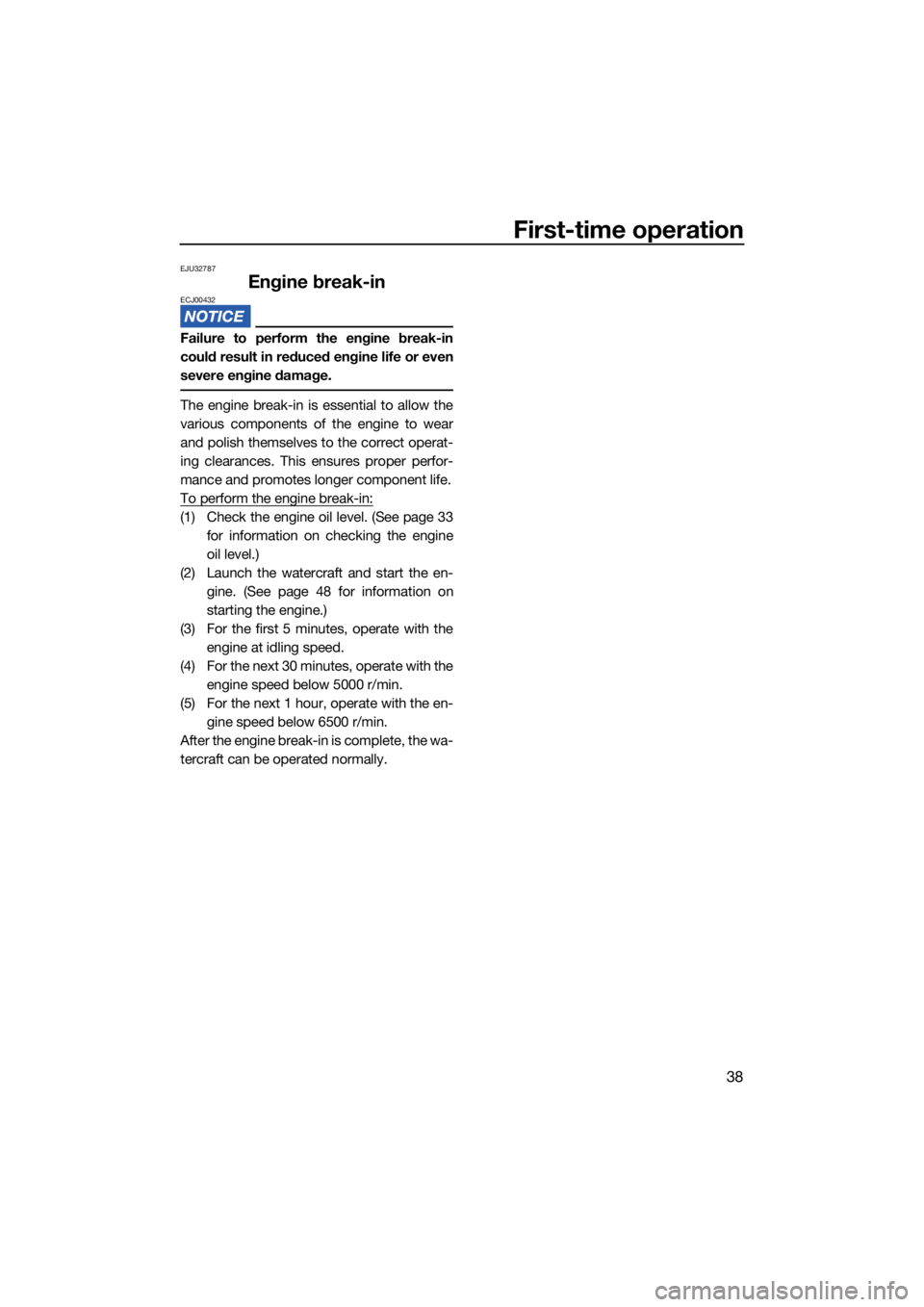
First-time operation
38
EJU32787
Engine break-inECJ00432
Failure to perform the engine break-in
could result in reduced engine life or even
severe engine damage.
The engine break-in is essential to allow the
various components of the engine to wear
and polish themselves to the correct operat-
ing clearances. This ensures proper perfor-
mance and promotes longer component life.
To perform the engine break-in:
(1) Check the engine oil level. (See page 33for information on checking the engine
oil level.)
(2) Launch the watercraft and start the en- gine. (See page 48 for information on
starting the engine.)
(3) For the first 5 minutes, operate with the engine at idling speed.
(4) For the next 30 minutes, operate with the engine speed below 5000 r/min.
(5) For the next 1 hour, operate with the en- gine speed below 6500 r/min.
After the engine break-in is complete, the wa-
tercraft can be operated normally.
UF4R71E0.book Page 38 Monday, May 10, 2021 1:14 PM
Page 46 of 84
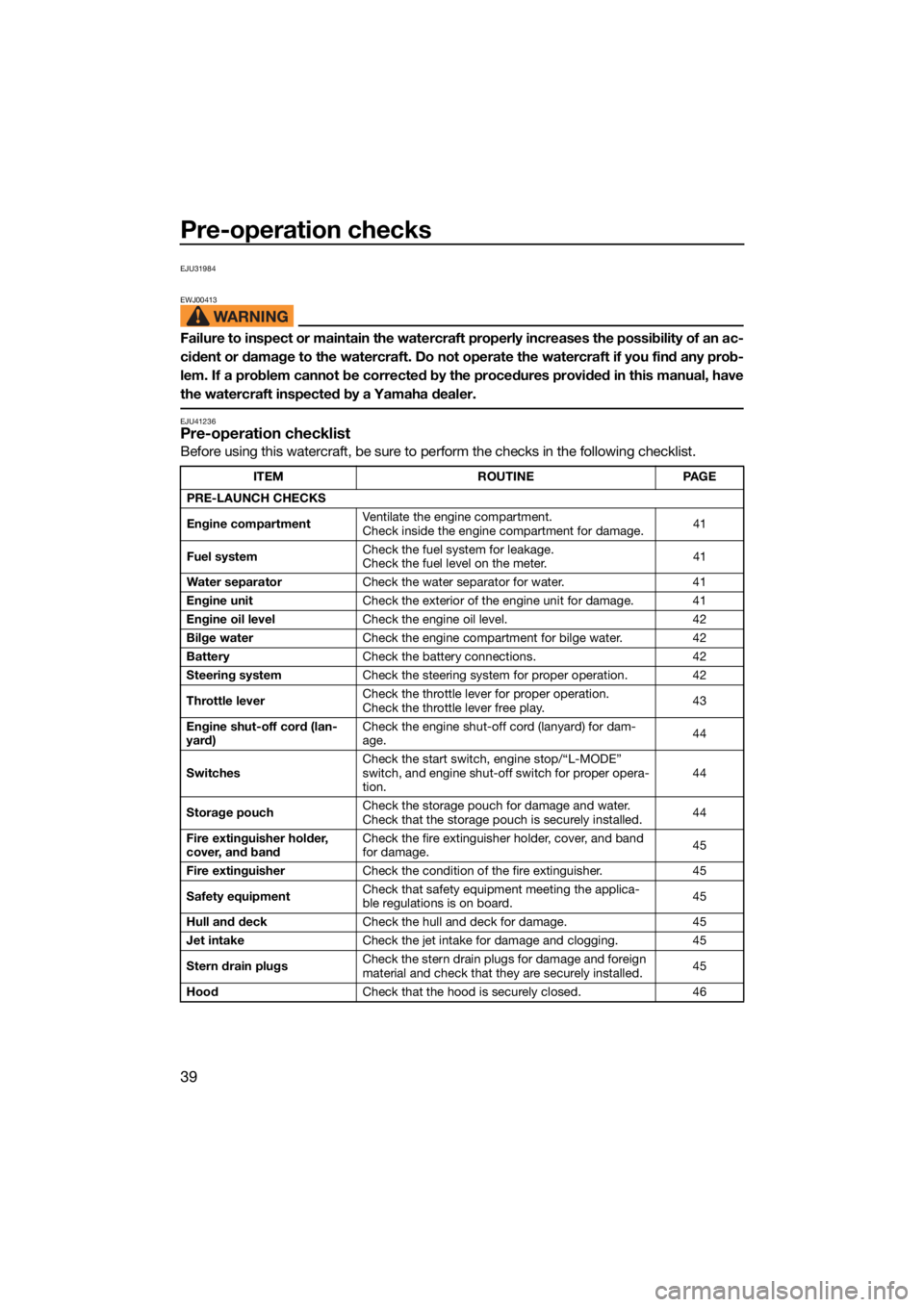
Pre-operation checks
39
EJU31984
EWJ00413
Failure to inspect or maintain the watercraft properly increases the possibility of an ac-
cident or damage to the watercraft. Do not operate the watercraft if you find any prob-
lem. If a problem cannot be corrected by the procedures provided in this manual, have
the watercraft inspected by a Yamaha dealer.
EJU41236Pre-operation checklist
Before using this watercraft, be sure to perform the checks in the following checklist.
ITEMROUTINEPAGE
PRE-LAUNCH CHECKS
Engine compartment Ventilate the engine compartment.
Check inside the engine compartment for damage.
41
Fuel system Check the fuel system for leakage.
Check the fuel level on the meter.
41
Water separator Check the water separator for water. 41
Engine unit Check the exterior of the engine unit for damage. 41
Engine oil level Check the engine oil level. 42
Bilge water Check the engine compartment for bilge water. 42
Battery Check the battery connections. 42
Steering system Check the steering system for proper operation. 42
Throttle lever Check the throttle lever for proper operation.
Check the throttle lever free play.
43
Engine shut-off cord (lan-
yard) Check the engine shut-off cord (lanyard) for dam-
age.
44
Switches Check the start switch, engine stop/“L-MODE”
switch, and engine shut-off switch for proper opera-
tion. 44
Storage pouch Check the storage pouch for damage and water.
Check that the storage pouch is securely installed.
44
Fire extinguisher holder,
cover, and band Check the fire extinguisher holder, cover, and band
for damage.
45
Fire extinguisher Check the condition of the fire extinguisher. 45
Safety equipment Check that safety equipment meeting the applica-
ble regulations is on board.
45
Hull and deck Check the hull and deck for damage. 45
Jet intake Check the jet intake for damage and clogging. 45
Stern drain plugs Check the stern drain plugs for damage and foreign
material and check that they are securely installed.
45
Hood Check that the hood is securely closed. 46
UF4R71E0.book Page 39 Monday, May 10, 2021 1:14 PM
Page 47 of 84

Pre-operation checks
40
TIP:
To ensure safety and reliability, pre-operation checks should be made each time the water-
craft is used.
POST-LAUNCH CHECKS
Cooling water pilot outlet Check that water is discharged from the cooling
water pilot outlet while the engine is running.
46
Meter When the engine is started, check that the meter
lighting comes on for a few seconds and then goes
off. 46
ITEM
ROUTINEPAGE
UF4R71E0.book Page 40 Monday, May 10, 2021 1:14 PM
Page 48 of 84
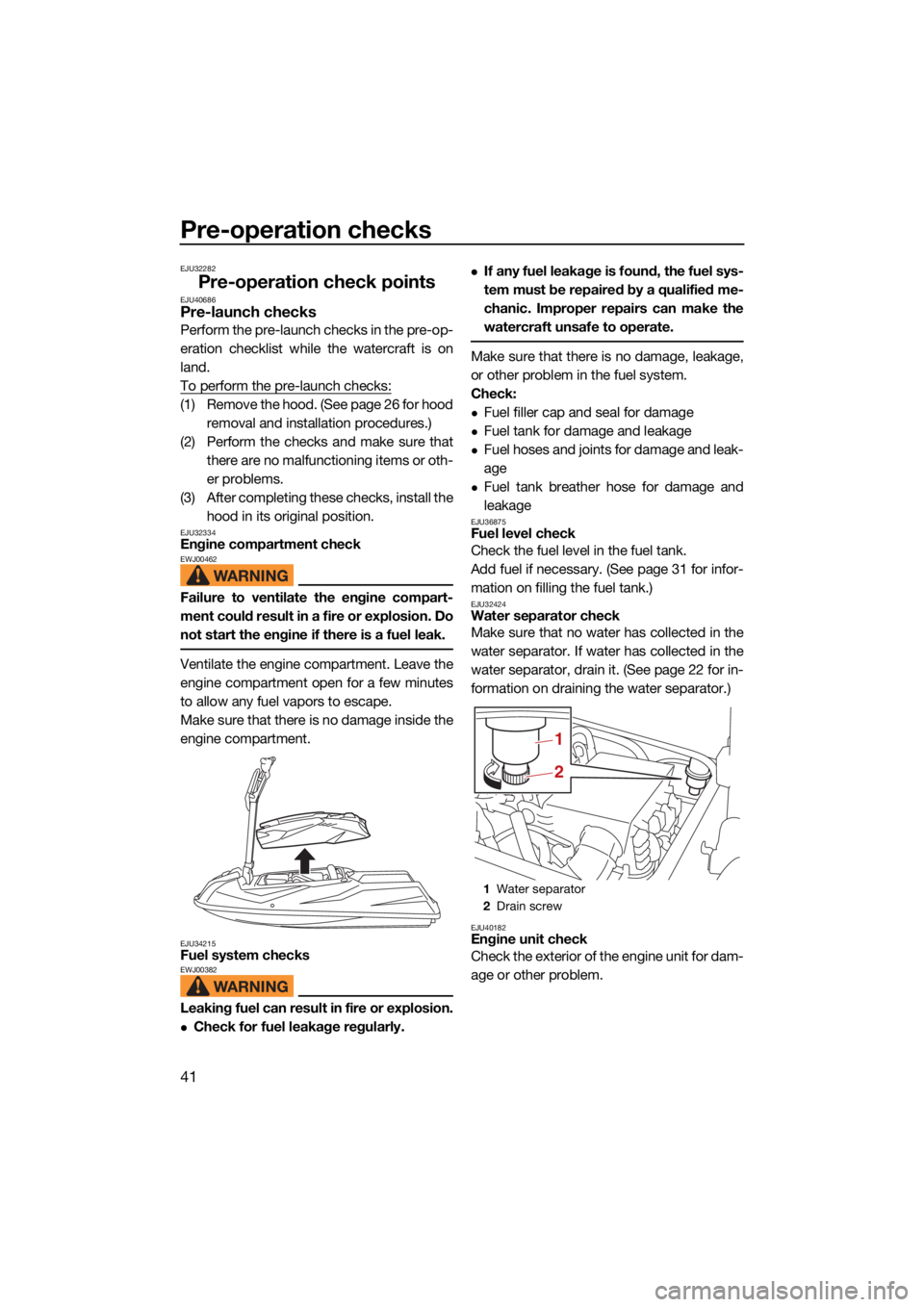
Pre-operation checks
41
EJU32282
Pre-operation check pointsEJU40686Pre-launch checks
Perform the pre-launch checks in the pre-op-
eration checklist while the watercraft is on
land.
To perform the pre-launch checks:
(1) Remove the hood. (See page 26 for hoodremoval and installation procedures.)
(2) Perform the checks and make sure that there are no malfunctioning items or oth-
er problems.
(3) After completing these checks, install the hood in its original position.
EJU32334Engine compartment checkEWJ00462
Failure to ventilate the engine compart-
ment could result in a fire or explosion. Do
not start the engine if there is a fuel leak.
Ventilate the engine compartment. Leave the
engine compartment open for a few minutes
to allow any fuel vapors to escape.
Make sure that there is no damage inside the
engine compartment.
EJU34215Fuel system checksEWJ00382
Leaking fuel can result in fire or explosion.
Check for fuel leakage regularly.
If any fuel leakage is found, the fuel sys-
tem must be repaired by a qualified me-
chanic. Improper repairs can make the
watercraft unsafe to operate.
Make sure that there is no damage, leakage,
or other problem in the fuel system.
Check:
Fuel filler cap and seal for damage
Fuel tank for damage and leakage
Fuel hoses and joints for damage and leak-
age
Fuel tank breather hose for damage and
leakage
EJU36875Fuel level check
Check the fuel level in the fuel tank.
Add fuel if necessary. (See page 31 for infor-
mation on filling the fuel tank.)
EJU32424Water separator check
Make sure that no water has collected in the
water separator. If water has collected in the
water separator, drain it. (See page 22 for in-
formation on draining the water separator.)
EJU40182Engine unit check
Check the exterior of the engine unit for dam-
age or other problem.
1Water separator
2 Drain screw
2
1
UF4R71E0.book Page 41 Monday, May 10, 2021 1:14 PM
Page 49 of 84
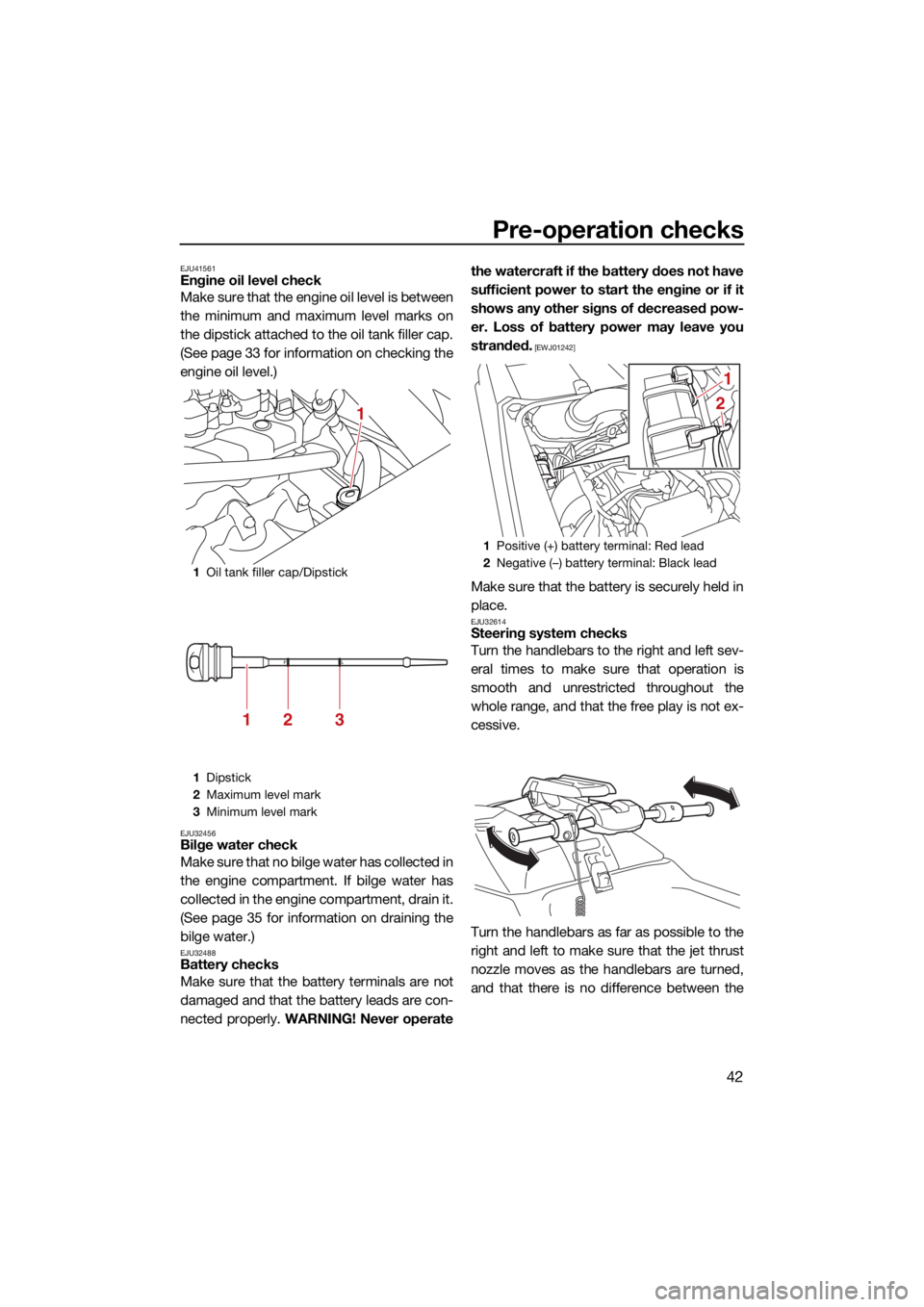
Pre-operation checks
42
EJU41561Engine oil level check
Make sure that the engine oil level is between
the minimum and maximum level marks on
the dipstick attached to the oil tank filler cap.
(See page 33 for information on checking the
engine oil level.)
EJU32456Bilge water check
Make sure that no bilge water has collected in
the engine compartment. If bilge water has
collected in the engine compartment, drain it.
(See page 35 for information on draining the
bilge water.)
EJU32488Battery checks
Make sure that the battery terminals are not
damaged and that the battery leads are con-
nected properly. WARNING! Never operate the watercraft if the battery does not have
sufficient power to start the engine or if it
shows any other signs of decreased pow-
er. Loss of battery power may leave you
stranded.
[EWJ01242]
Make sure that the battery is securely held in
place.
EJU32614Steering system checks
Turn the handlebars to the right and left sev-
eral times to make sure that operation is
smooth and unrestricted throughout the
whole range, and that the free play is not ex-
cessive.
Turn the handlebars as far as possible to the
right and left to make sure that the jet thrust
nozzle moves as the handlebars are turned,
and that there is no difference between the
1
Oil tank filler cap/Dipstick
1 Dipstick
2 Maximum level mark
3 Minimum level mark
1
213
1Positive (+) battery terminal: Red lead
2 Negative (–) battery terminal: Black lead
1
2
UF4R71E0.book Page 42 Monday, May 10, 2021 1:14 PM
Page 50 of 84
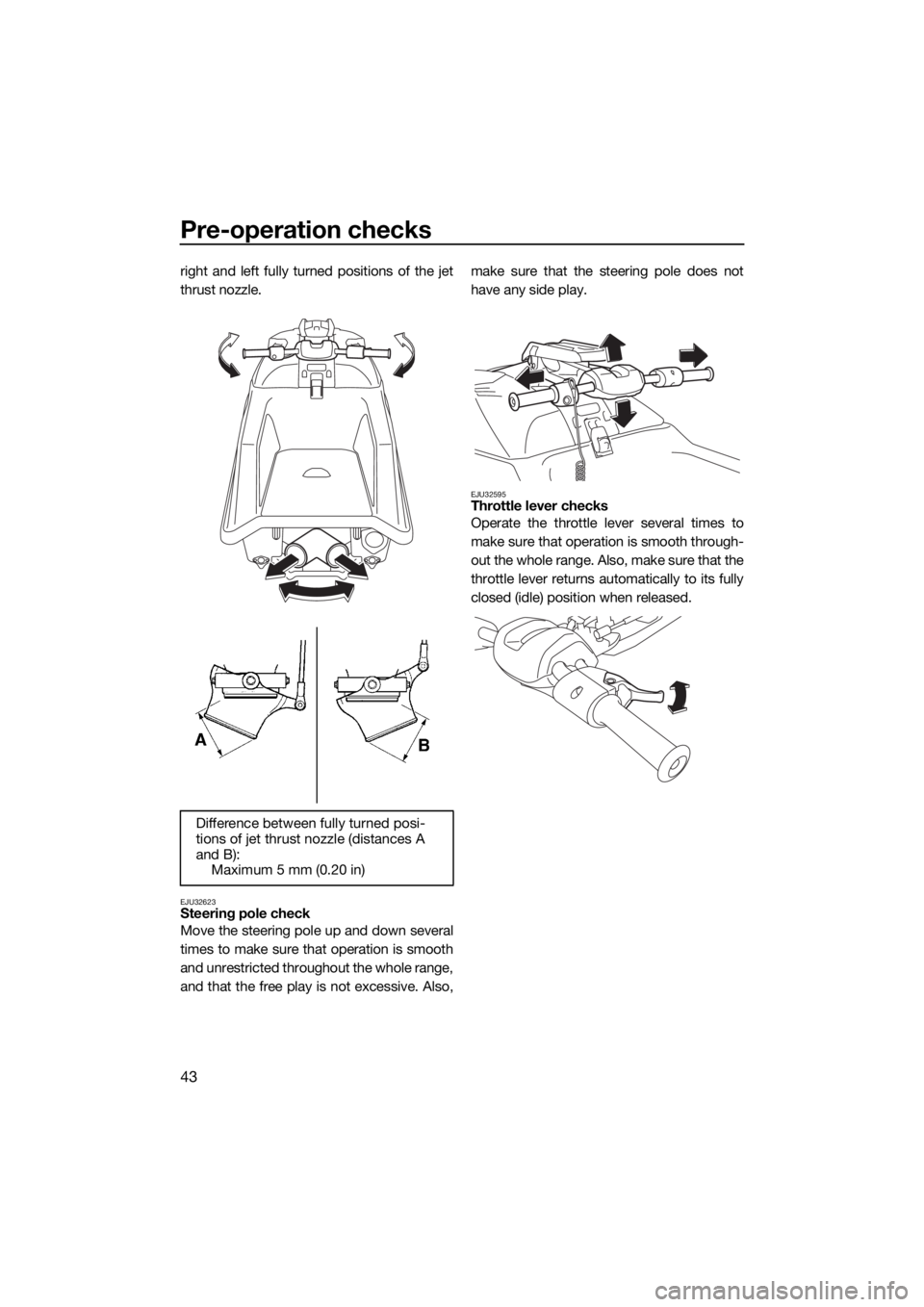
Pre-operation checks
43
right and left fully turned positions of the jet
thrust nozzle.
EJU32623Steering pole check
Move the steering pole up and down several
times to make sure that operation is smooth
and unrestricted throughout the whole range,
and that the free play is not excessive. Also, make sure that the steering pole does not
have any side play.
EJU32595Throttle lever checks
Operate the throttle lever several times to
make sure that operation is smooth through-
out the whole range. Also, make sure that the
throttle lever returns automatically to its fully
closed (idle) position when released.
Difference between fully turned posi-
tions of jet thrust nozzle (distances A
and B): Maximum 5 mm (0.20 in)
UF4R71E0.book Page 43 Monday, May 10, 2021 1:14 PM